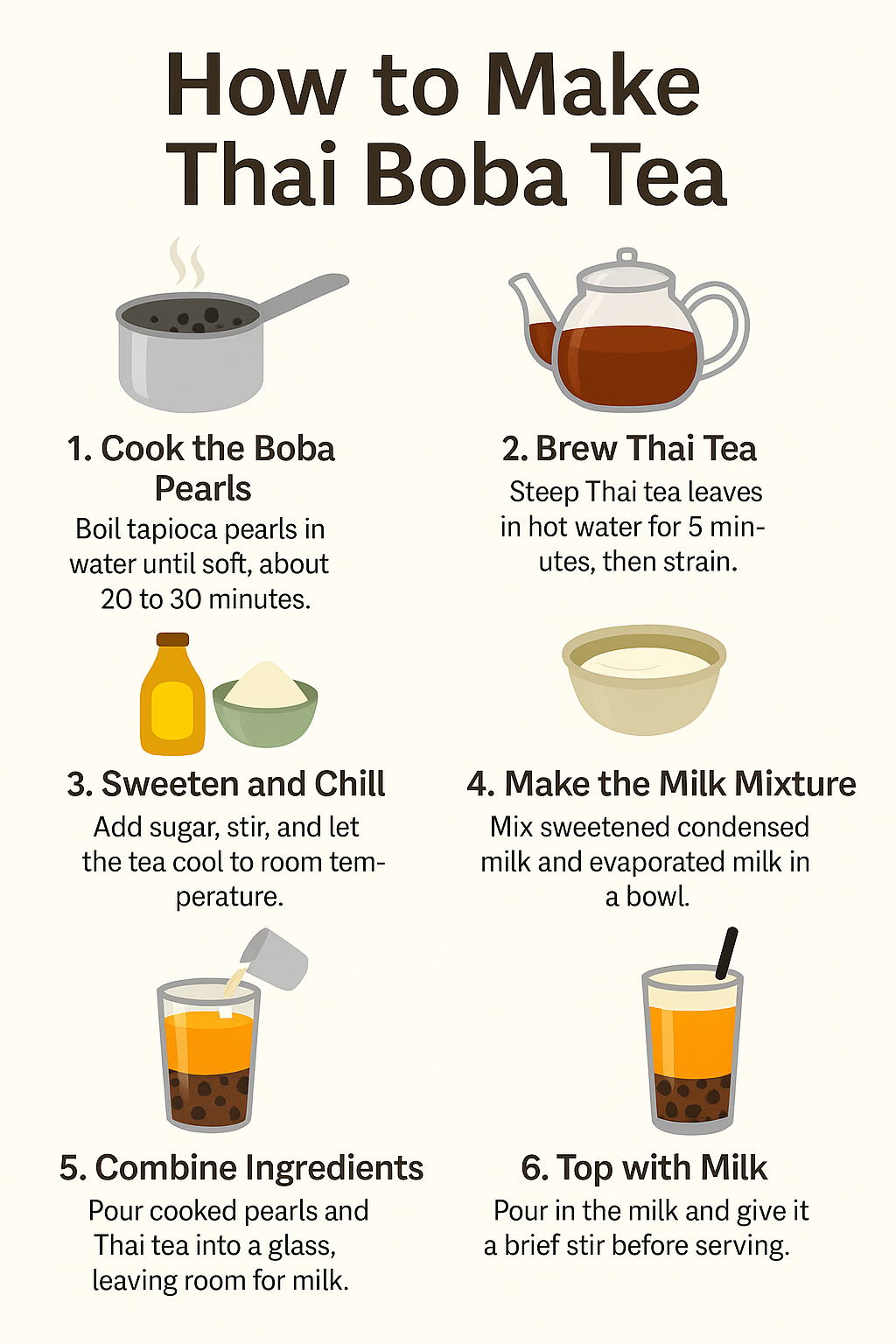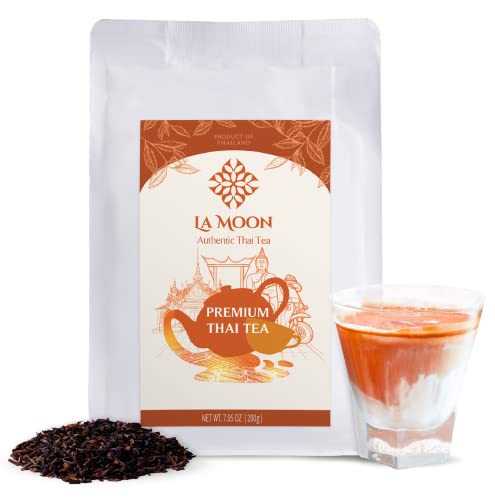Thai Boba Tea: Benefits, Recipe, Taste, and How to Make It
Thai Boba Tea, often called Thai Milk Tea with Tapioca Pearls, is one of those drinks that immediately catches your eye before it wins your taste buds. With its vibrant orange hue, creamy swirl, and chewy boba pearls, it’s both a visual treat and a comfort in a cup. Originating from Thailand’s famous street vendors, this tea has traveled across the world — finding a home in cafés from New York to Tokyo.
What makes Thai Boba Tea special is its perfect balance of strong brewed tea, creamy sweetness, and a hint of spice. Traditional Thai tea uses a black tea base infused with spices like star anise or tamarind, giving it a distinct flavor that sets it apart from other milk teas. When mixed with sweetened condensed milk and chewy tapioca pearls, it becomes a refreshing indulgence with texture and depth.
Today, Thai Boba Tea isn’t just a beverage — it’s a cultural bridge between East and West. Whether you sip it on a hot afternoon or as a dessert alternative, its rich flavor, smooth texture, and bold aroma make it an instant favorite. Studies on tea-based beverages highlight how black tea contributes antioxidants and mild caffeine stimulation that can improve focus and alertness (1).
What Is Thai Boba Tea?
Thai Boba Tea is a sweet, creamy, and aromatic beverage that combines the essence of traditional Thai iced tea with the playful chewiness of tapioca pearls. It’s made from a strong Ceylon or Assam black tea base, steeped with sugar and flavored with spices such as cardamom, star anise, and tamarind. The mixture is then blended with sweetened condensed milk or evaporated milk to create its signature rich texture and deep amber-orange color.
The “boba” portion comes from tapioca pearls, small chewy balls made from cassava starch that sink to the bottom of the glass. These pearls add texture and make the drink as fun to chew as it is to sip. When served over ice, the drink is smooth, sweet, and refreshing — with a balance between robust tea flavor and creamy sweetness.
Nutritionally, Thai Boba Tea contains caffeine from the black tea base, typically ranging from 40 to 60 mg per 16-ounce serving, depending on brew strength and tea leaves used. This makes it a moderate stimulant, offering a gentle energy lift without the intensity of coffee. Its calorie content can vary from 300 to 500 kcal per serving, mostly from added milk and sugar. However, with a few substitutions like plant-based milk and low-sugar syrup, it can be made much lighter.
According to research, black tea offers polyphenols — compounds that help reduce oxidative stress and support cardiovascular health, which adds a touch of wellness to this indulgent treat (2).
Benefits of Thai Boba Tea
While Thai Boba Tea is often enjoyed as a dessert drink, it also carries several surprising benefits when consumed mindfully. Below are some of the most notable advantages — especially when it’s made with real tea and natural ingredients.
1. Boosts Energy and Mood
The black tea base in Thai Boba Tea provides a gentle caffeine boost that helps improve alertness without the jittery crash often caused by coffee. Combined with its natural sweetness, the drink offers an immediate uplift in mood and focus — perfect for afternoon slumps or long study sessions.
Caffeine also triggers the release of dopamine, the “feel-good” neurotransmitter that promotes motivation and relaxation, making every sip as emotionally satisfying as it is energizing (3).
2. Provides Antioxidant Support
Because Thai tea is brewed from black tea leaves, it contains polyphenols and catechins — plant compounds known for fighting oxidative stress. These antioxidants help protect cells from damage caused by free radicals, potentially supporting heart health and long-term wellness.
Regular consumption of black tea has been linked to improved blood vessel function and reduced inflammation, helping the body maintain balance even with occasional indulgence like boba pearls (4).
3. Can Aid Digestion (When Modified)
Traditional Thai tea is often made with condensed milk, which can be heavy for some people. However, when prepared with lighter alternatives such as oat milk, almond milk, or coconut milk, it becomes easier to digest while still retaining a smooth, creamy texture.
Black tea itself may help stimulate digestive enzymes, easing mild bloating or sluggish digestion. Sipping it slowly after a meal — with less sugar — can provide a refreshing, digestive-friendly option compared to sugary sodas.
What Does Thai Boba Tea Taste Like?
Thai Boba Tea is one of those rare drinks where taste, aroma, and texture come together in perfect harmony. The first sip hits you with a creamy sweetness, followed by a deep, malty black tea flavor, and then the subtle chew of tapioca pearls that keeps you coming back for more. It’s indulgent yet balanced — rich without being overwhelming.
The defining note of Thai tea comes from its spiced undertones. Most blends use ingredients like star anise, tamarind, vanilla, or cardamom, which lend a warm and aromatic complexity. When these are steeped with robust Ceylon or Assam tea and sweetened milk, the result is a drink that’s both bold and comforting. The orange color (often from added food coloring or natural annatto seed) adds a vibrant visual appeal that matches its flavor intensity.
Texture also plays a big role in the Thai Boba Tea experience. The tapioca pearls add a playful contrast to the smooth liquid, giving the drink its signature chewiness. Depending on your preference, the pearls can be soaked in brown sugar or honey for extra depth, while crushed ice brings a refreshing finish on a warm day.
In short, the taste can be described as sweet, creamy, spiced, and slightly earthy — like a cross between a chai latte and a dessert milk tea. It’s a comforting blend that’s both energizing and indulgent. Research also notes that tea flavor perception is enhanced by the balance of aroma compounds and fat content, explaining why milk-based teas like Thai Boba are particularly satisfying (5).
How to Make Thai Boba Tea (Recipe & Brewing Guide)

Making Thai Boba Tea at home is easier than it looks, and it gives you full control over sweetness, milk type, and calorie content. Here’s a simple recipe for a classic version — plus a lighter variation if you prefer a healthier twist.
Ingredients (Serves 2)
| Ingredient | Amount | Notes |
|---|---|---|
| Thai tea mix (loose leaves or tea bags) | 4 tbsp | Brands like Pantai or Number One Hand Brand work best |
| Water | 2 cups | Use filtered water for clean flavor |
| Sweetened condensed milk | 2 tbsp | Adjust to taste or swap for coconut milk |
| Evaporated milk or whole milk | ½ cup | For creaminess |
| Sugar or honey (optional) | 1–2 tsp | Can be reduced or replaced with stevia |
| Tapioca pearls (boba) | ½ cup | Cook according to package instructions |
| Ice cubes | As needed | Crushed ice works best |
Step-by-Step Brewing Guide
- Brew the Tea Base Bring 2 cups of water to a boil. Add Thai tea leaves and let steep for 5–7 minutes until the liquid turns a deep orange-brown. Strain the tea into a heatproof jug and allow it to cool slightly.
- Prepare the Tapioca Pearls Boil the tapioca pearls in water until they float to the top (about 5–7 minutes). Turn off the heat, cover, and let them sit for another 5 minutes. Drain and mix them with a teaspoon of brown sugar or honey to prevent sticking.
- Sweeten and Mix Add the condensed milk and evaporated milk to the brewed tea while it’s still warm. Stir until combined. Taste and adjust sweetness as needed.
- Assemble the Drink Scoop the cooked tapioca pearls into a tall glass, add ice, and pour the tea mixture on top. Stir gently to combine.
- Serve and Enjoy Insert a wide straw and enjoy immediately. For a lighter version, use almond or oat milk and skip the condensed milk for a refreshing, dairy-free alternative.
Brewing tip: Thai tea’s bold flavor holds up well when served cold, but you can also enjoy it warm on cooler days. Just skip the ice and reduce sugar slightly for a smoother taste balance.
Possible Side Effects or Considerations
While Thai Boba Tea is undeniably delicious, it’s best enjoyed in moderation due to its rich, sweet ingredients and caffeine content. Below are a few important factors to keep in mind for your health and comfort.
1. High Sugar Content
Traditional Thai Boba Tea often contains sweetened condensed milk, evaporated milk, and syrup—all of which add up to significant sugar levels. A standard 16-ounce serving can contain 30–45 grams of sugar, nearly equivalent to a can of soda. Excessive sugar intake is associated with weight gain, insulin resistance, and other metabolic risks, so it’s best to treat it as an occasional indulgence rather than a daily habit. You can reduce sugar by asking for half-sweet or using stevia, honey, or monk fruit as natural alternatives.
2. Caffeine Sensitivity
Thai tea uses strong black tea leaves, which are naturally caffeinated. Depending on how it’s brewed, a single serving may contain 40–60 mg of caffeine—enough to boost alertness but also cause restlessness or insomnia if consumed too late in the day. If you’re caffeine-sensitive, try decaf black tea or switch to herbal versions that mimic Thai tea flavor without caffeine.
3. Dairy Intolerance
Since traditional Thai Boba Tea is made with dairy-based condensed and evaporated milk, those who are lactose intolerant may experience bloating, gas, or discomfort. Replacing dairy with oat milk, almond milk, or coconut milk preserves the creamy texture while making it more digestible and vegan-friendly.
FAQs About Thai Boba Tea
Thai Boba Tea can be part of an occasional treat, but it’s not considered a health drink due to its high sugar and calorie content. Using low-fat milk and reducing added sweeteners can make it a lighter option.
Yes. It’s made from black tea, which typically contains 40–60 mg of caffeine per cup. If you’re caffeine-sensitive, try reducing steep time or using decaffeinated tea leaves.
Absolutely. Swap condensed and evaporated milk with coconut milk or almond milk, and use plant-based sweeteners. You’ll get the same creamy flavor without the dairy.
Fresh Thai Boba Tea tastes best within 24 hours. The tapioca pearls harden over time, so it’s best to prepare them right before serving.
Thai Boba Tea is brewed from strong black tea (often Ceylon or Assam) and flavored with warm spices like star anise, tamarind, and vanilla. It’s creamier and more aromatic than typical milk tea varieties.
Conclusion
Thai Boba Tea is a fusion of bold black tea, fragrant spices, and creamy sweetness that offers both refreshment and indulgence. When enjoyed in moderation, it’s a wonderful way to experience the artistry of Southeast Asian tea culture. Whether you prefer it rich and classic or light and dairy-free, the key is balance — between taste, health, and enjoyment.
For the best experience, brew it fresh, enjoy it slowly, and savor the layered notes of spice, milk, and tea that make Thai Boba so special.


